Geckeler K.E., Nishide H. (Eds.) Advanced Nanomaterials
Подождите немного. Документ загружается.


23.5 Dispersion of Carbon Nanotubes in Biopolymers 719
nanotubes. Thus, the noncovalent functionalizaton of CNT with different poly-
mers or organic molecules has attracted great attention.
23.5
Dispersion of Carbon Nanotubes in Biopolymers
Synergetic effects with biomolecules on CNTs has attracted much attention for a
wide range of biotechnological applications, including sensors, cancer therapy [18] ,
drug delivery [19] , tissue engineering, and antimicrobial surfaces [20] . The results
of recent studies have shown CNTs to be compatible with mammalian cells and
neurons [21] , with CNT - based composites having been identifi ed as excellent
materials for scaffolds for neuron growth [22] and bone proliferation [23] , as well
as having potential for tissue engineering [24] . These types of bio - focused com-
posites have been prepared using a variety of natural biopolymers, including
different polysaccharides, polypeptides, and polynucleotides (Figure 23.2 ) [2] .
Interestingly, the biopolymers have shown much promise, since “ mother Nature ”
has provided an abundance of well - designed polymers for defi ned applications.
The exploration of these molecules in conjunction with nanotubes not only facili-
tates the creation of suitable products from abundantly available resources, but
also assists in mimicking their smart functions for the advancement of nanotube -
based devices. For example, a degree of success has been achieved in preparing a
unique supramolecular conjugate of nanotubes and lysozyme ( LSZ ), one of the
most common proteins. In this way, novel properties could be induced (i.e., pH -
sensitive dispersion and debundalization of the nanotubes) that directly gave their
signal simply by switching photoluminescence. A similar success was achieved
when nanotubes were individually dispersed, using different proteins.
Recently, biopolymer integration has attracted much attention due to their
increased compatibility with biological systems compared to synthetic materials.
Consequently, a variety of biopolymers was chosen in order to monitor their effi -
ciency for the dispersion of CNTs. For example, Rozen et al. [25] used the water -
soluble polysaccharide gum arabica to obtain a stable dispersion of individual,
full - length tubes in an aqueous solution from as - produced SWNTs. Wenseleers
et al. [26] reported an effi cient isolation of pristine SWNTs in bile salts, such as
the sodium salts of deoxycholic acid ( DOC ) and their taurine - substituted analogue
Figure 23.2 Schematic diagram of the wrapping of single -
walled carbon nanotubes by biopolymers.

720 23 Interactions of Carbon Nanotubes with Biomolecules: Advances and Challenges
taurodeoxycholic acid ( TDOC ), simply by stirring at room temperature. When
using this process it is possible to avoid damage induced on the walls of the
SWNTs during ultrasonication. The effi ciency of debundalization of the SWNTs
was monitored using NIR, fl uorescence, and Raman spectroscopies. Most interest-
ingly, a dramatically improved resolution of the radial breathing mode s ( RBM s)
in the Raman spectra with multi - peaks was obtained with the bile salts, in contrast
to the single peak obtained in most previous studies with arc discharge tubes.
When the ability of the salts to disperse the SWNTs was compared with other
common surfactants, by using NIR spectroscopy, among the most common
surfactants, both DOC and TDOC (i.e., anionic, nonionic, cationic) showed the
highest dispersion powers (fi ve - to 20 - fold higher).
A water - soluble product also has great potential in the design of an electrode for
bioelectrochemical sensors, by taking advantage of the noncovalent interactions
of chitosan with CNTs [27] . Hasegawa et al. showed that biopolymers such as
Schizophyllan (s - SPG) and curdlan were capable of wrapping SWNTs, creating a
“ periodical ” helical structure that refl ected the helical nature of the SPG main -
chain on the SWNT surface [28] . Kim et al . [28] reported a simple, but effi cient,
process for the solubilization of SWNTs with amylose in aqueous dimethylsulfox-
ide ( DMSO ), by using sonication. The former step separated the SWNT bundles,
while the latter step provided a maximum cooperative interaction of SWNTs with
amylose, leading to an immediate and complete solubilization. Both, scanning
electron microscopy ( SEM ) and atomic force microscopy ( AFM ) images of the
encapsulated SWNTs appeared as loosely twisted ribbons wrapped around the
SWNTs, which were locally intertwined as a multiple twist; however, no clumps
of the host amylose were seen on the SWNT capsules.
The potential of CNTs for the development of novel bioelectronic devices has
been realized and, indeed, biomolecules have been immobilized on CNTs [29] .
The major benefi t in choosing biomolecules is to take advantage of their ampho-
teric nature to render the nanotubes processable, while simultaneously utilizing
their unique properties to design novel artifi cial systems. In this respect, a variety
of biomolecules hold great promise for this type of development.
Here, attention is focused on DNA and proteins for the interaction with CNTs.
The major motivation to use these polymers includes: (i) their unique features and
typical characteristics, as well as their diversity, which controls almost every living
system in Nature; and (ii) the potential to bring about novel possibilities by uniting
them, as this can have huge impact on both basic and applied research.
23.6
Interaction of DNA with Carbon Nanotubes
The interaction of DNA with CNTs has been a major focus of recent research
[30 – 32] , due mainly to the unique structure of DNA (Figure 23.3 ) and its properties
with regard to both biological and nonbiological applications. For instance, recent
reports have already focused on several applications as a new material, including
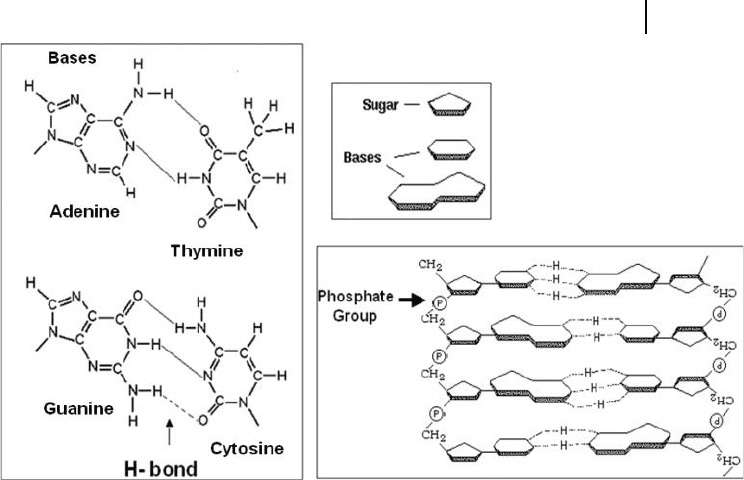
23.6 Interaction of DNA with Carbon Nanotubes 721
drug delivery [33, 34] , molecular electronics, nanoscale robotics [35] , computation
[36] , self - assembly, 1 - D electron conduction [34] , and photonics [37] . When con-
sidering the huge potential of CNTs, a combination of DNA with CNTs in the
quest to identify new and advanced performances for a wide range of synthetic
systems has been of vast interest. Yet, the major attraction for DNA has been based
on a recent breakthrough which described its ability to individually disperse CNTs
in aqueous solutions, under controlled conditions [32, 38, 39] , and this has in turn
led to many other possibilities.
The fi rst report on the direct interaction of DNA with CNT was made by Tsang
et al ., in a study which was based on the visualization of CNT by platinated oligo-
nucleotides [40] . The major breakthrough in this fi eld was based on the ability of
DNA to disperse CNTs individually in water [30, 38] , while others reported on a
DNA - assisted dispersion of CNTs [39, 41] . All of these studies were based on the
noncovalent functionalization of DNA with nanotubes. The covalent bonding of
DNA with SWNTs [42] has been also reported, while fi eld effect transistors [43]
using such materials have also been studied.
Previously, the use of mechanochemical reactions has been suggested [44] as a
generally effi cient technique for various processes and, by using the same approach,
supramolecular adducts of DNA – CNT conjugates have been reported [39] . Highly
reactive centers generated on the CNTs by the mechanical energy in the solid state
helped to promote good interactions with DNA (Figure 23.4 ), which in turn led
to a short - length, highly water - soluble, CNT - based product in a single step. This
Figure 23.3 Schematic showing the chemical structure of
DNA, which is composed of the four different bases, sugar
(ribose), and phosphate groups.
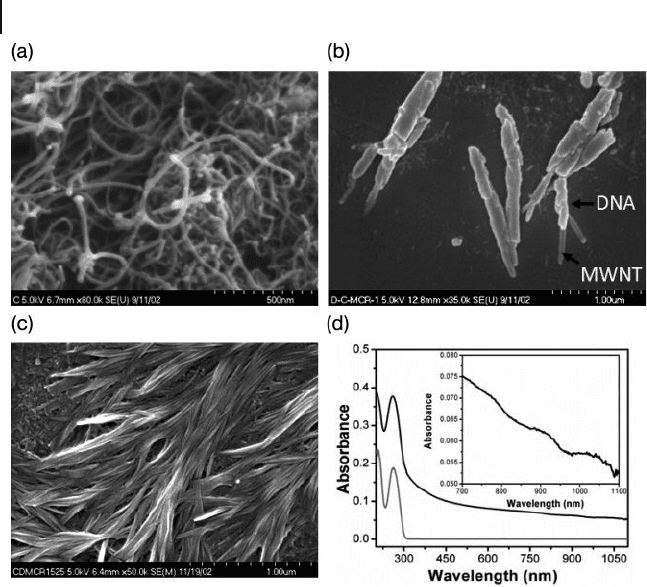
722 23 Interactions of Carbon Nanotubes with Biomolecules: Advances and Challenges
technique has also been used successfully to prepare both fullerene derivatives
[45] and alcohol - functionalized CNTs [46] Interestingly, this soluble CNT product
appeared fully wrapped with DNA and seemed to differ from that described in
previous reports on mechanochemical reactions for covalently functionalized
products [46] .
Zheng et al. obtained individual SWNTs in a solution of single - stranded DNA
( ssDNA ) [30, 38, 47] . Notably, removal of the free DNA by either anion - exchange
column chromatography or nuclease digestion did not cause any fl occulation of
the nanotubes, indicating that binding of the DNA to the SWNTs was very strong.
In order to obtain putative binding structures and to approximately quantify the
thermodynamics of binding, Zheng ’ s group simulated interactions between
ssDNA molecules and nanotubes with a (10,0) - chiral vector. As a consequence, it
appeared that the short ssDNA strands could bind in many ways to the nanotube
surface, including helical wrapping with right - and left - handed turns, or simply
by surface adsorption with a linearly extended structure. The bases could extend
from the backbone and stack onto the nanotube, whereas the sugar - phosphate
backbone could lead to solubilization of the SWNTs. The phosphate groups of the
Figure 23.4 Scanning electron microscopy images. (a) Pristine
CNT; (b) CNT – DNA conjugate; (c) Self - assembly of the
CNT – DNA conjugate; (d) UV - visible - NIR absorbance spectra
of DNA (gray) and DNA – MWNT dispersion (black). The inset
shows the van Hove transitions of the semiconducting
nanotubes.

23.7 Interaction of Proteins with Carbon Nanotubes 723
product provided a negative charge density on the surface and affected the surface
charge of the nanotubes, which was directly related to the electronic properties of
the SWNTs. In this respect, DNA - met - SWNTs were found to have a lower surface
charge than DNA - sem - SWNTs, due to the greater positive charge created in the
met - SWNTs. This led to a successful separation of met - SWNTs from sem - SWNTs
by using ion - exchange liquid chromatography. Moreover, by measuring the elec-
tronic absorption spectra for all fractions, a remarkable difference was noted
between the early fractions, which were enriched with met - SWNTs, and the later
fractions, which were enriched with sem - SWNTs.
23.7
Interaction of Proteins with Carbon Nanotubes
The main focus of preparing debundalized SWNTs with the aid of proteins was
motivated by the outstanding properties that each of these proteins display in the
natural environment. This offers the possibility to bring functionality into syn-
thetic systems, if the correct technology were to be developed. A broad range of
different types are available in Nature, which allows complicated synthetic proce-
dures to be avoided and their compatibility with biological systems to be enhanced,
when compared to synthetic materials. In addition, the intrinsic smart function
in a synthetic system may be mimicked [2, 48] . Functionalization is possible by
both the covalent and noncovalent approaches. For example, CNTs may be func-
tionalized by the protein bovine serum albumin ( BSA ) via a diimide - activated
amidation, under ambient conditions [49] . The nanotube – BSA conjugates thus
obtained are highly water - soluble, and form dark - colored aqueous solutions.
Results from characterizations using AFM, thermal gravimetric analysis ( TGA ),
Raman spectroscopy and gel electrophoresis showed that the conjugate samples
indeed contained both CNTs and BSA proteins, and that the protein species were
intimately associated with the nanotubes. When the bioactivity of the nanotube -
bound proteins was evaluated using a total protein microdetermination assay, the
results showed that 90% of the protein species present in the nanotube – BSA
conjugates remained bioactive [49] .
Zorbas et al. [50] isolated long, individual SWNTs wrapped with a specially
designed peptide in aqueous solution by sonication and centrifugation. Based on
AFM studies, it was observed that the product contained SWNTs with an average
length of 1.2 ± 1.1 μ m and an average diameter of 2.4 ± 1.3 nm. Furthermore, the
peptide – peptide interactions apparently assisted the assembly of the SWNT struc-
tures, specifi cally in the formation of Y - , X - , and intraloop junctions. In this way,
apart from the debundalization and biocompatibility of the peptide – SWNT
product, their properties showed great potential for the development of SWNT -
based, higher - ordered structures. Similarly, the importance of aromatic groups of
the amino acid residues on the interaction with CNTs has been observed [51] .
Various systematically designed peptides with different types of amino acid
showed a stronger selectivity for CNTs than did peptides with a higher aromatic
residue content.
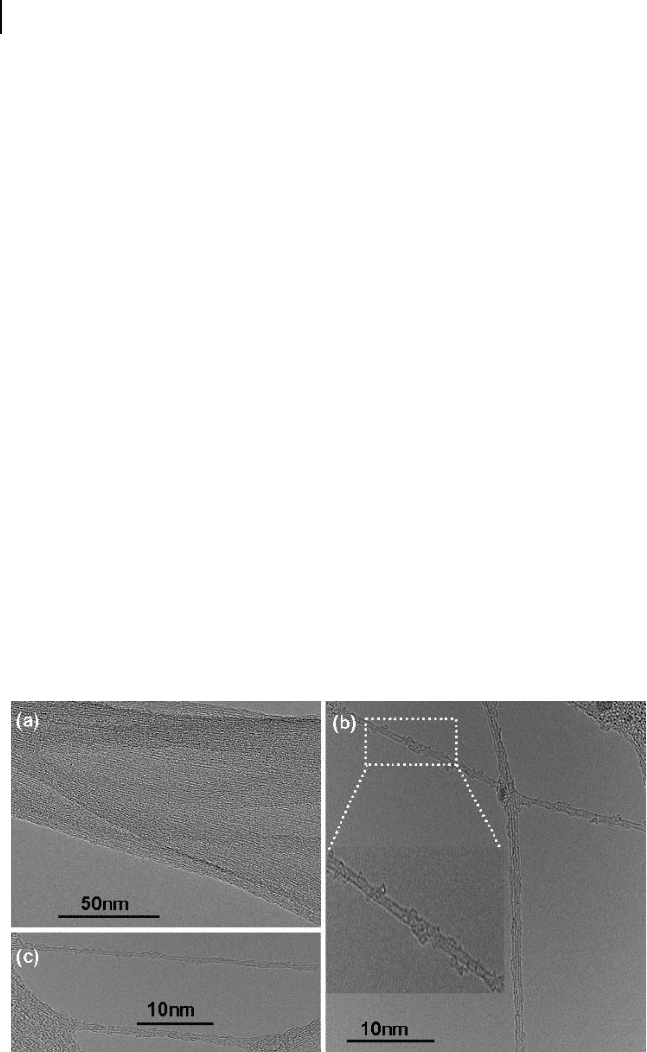
724 23 Interactions of Carbon Nanotubes with Biomolecules: Advances and Challenges
A study was conducted to evaluate the affi nity of aromatic amino acids toward
SWNTs in the absence of complications from peptide folding or self - association,
by synthesizing a series of surfactant peptides [52] . Each surfactant peptide was
designed with a lipid - like architecture: two Lys residues at the C - terminus as a
hydrophilic head; fi ve Val residues to form a hydrophobic tail; and the testing
amino acid at the N - terminus. Both, Raman and circular dichroism ( CD ) spectro-
scopic studies revealed that the surfactant peptides had a large, unordered struc-
tural component, which was independent of the peptide concentration. This
suggested that the peptides had undergone minimal association under experimen-
tal conditions, thus removing this interference from any interpretation of the
peptide – CNT interactions. A lack of peptide self - association was also indicated by
sedimentation equilibrium data. The optical spectroscopy of the peptide – CNT
dispersions indicated that, among the three aromatic amino acids, tryptophan had
the highest affi nity for CNTs (both bundled and individual states), when incorpo-
rated into a surfactant peptide, while the Tyr - containing peptide was more selective
for individual CNTs. A protein - assisted solubilization of nanotubes was also
reported [53] . Although these recent fi ndings have opened novel possibilities for
nanobiohybrid systems, it remains an overt issue as to whether there is any selec-
tivity and any effect of the proteins on the nanotubes. In addition, it is very impor-
tant to note that these natural polyampholytes are highly pH - sensitive, and that
their solubility and ionizability can easily be tuned with respect to pH. This, simul-
taneously, should infl uence the nanotube dispersion, which might offer novel
options for the precise control of selectivity towards nanotubes.
The present authors studied highly dispersed and debundalized CNTs (Figure
23.5 ), which had been prepared in an aqueous solution of LSZ, using a combina-
Figure 23.5 High - resolution transmission electron microscopy
images of (a) SWNT and (b, c) L - SWNT. The inset in
(b) shows the magnifi ed image of a nanotube.
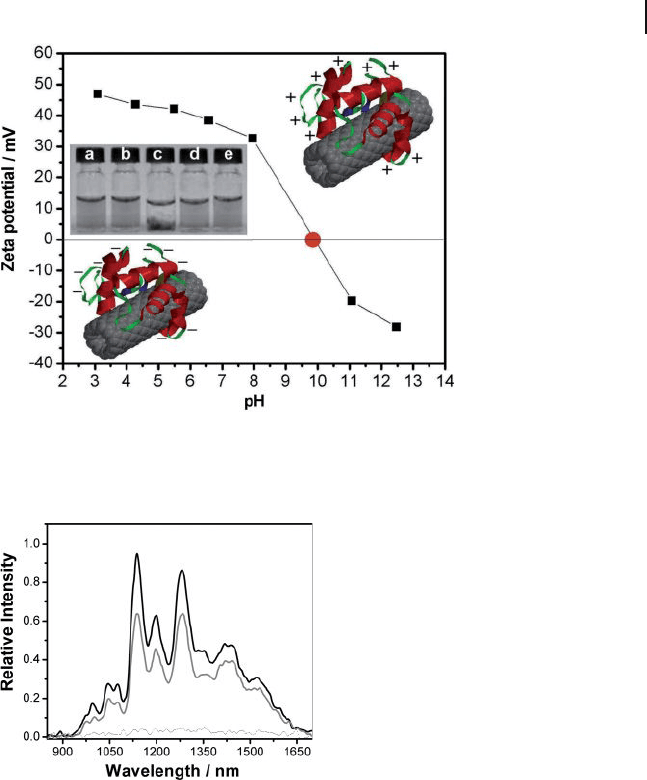
23.7 Interaction of Proteins with Carbon Nanotubes 725
tion of ultrasonication and ultracentrifugation [14] . The product showed a pH -
sensitive dispersion, which remained in a highly dispersed state at pH < 8 and
pH > 11, and in an aggregated state at pH = 8 – 11 (Figure 23.6 ). Photoluminescence
measurements showed that, by changing the pH, a reversible conversion of the
highly dispersed state to the aggregated state could be observed, or vice - versa
(Figure 23.7 ).
It is important to understand the nature of the interactions involved between
the LSZ and the SWNTs. LSZ has long been considered a structurally stable
Figure 23.6 Zeta potential of L - SWNT at different pH values.
The inset shows vials containing the products at different pH
values: (a) 2.95; (b) 6.5; (c) 9.0; (d) 11.15; (e) 12.47.
Figure 23.7 Photoluminescence spectrum of L - SWNT,
showing the pH - dependent reversibility in emission. The black
(solid), black (dotted), and gray (solid) curves are from the
solution at pH 12.5, same solution adjusted to pH 9.0, and
again readjusted to pH 12.5, respectively.
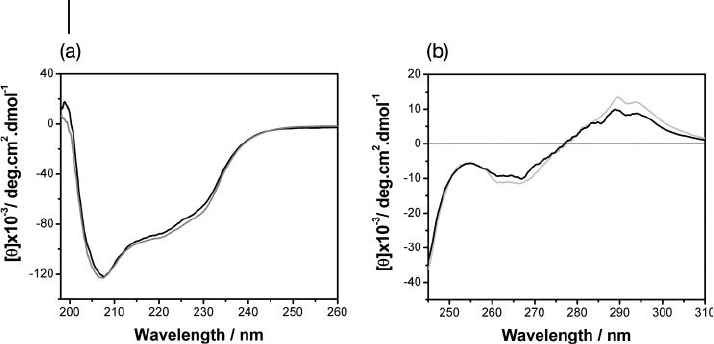
726 23 Interactions of Carbon Nanotubes with Biomolecules: Advances and Challenges
protein; hence, in order to appreciate the state of LSZ in the product, a CD analysis
of the samples was carried out in the far - and near - UV regions (Figure 23.8 ). It
has been well established that shorter wavelengths refl ect the secondary structure,
whereas longer wavelengths arise from the tertiary structure of proteins. A strong
negative band was appeared in the range of 200 – 260 nm. The signal intensity at
208 nm was greater than at 222 nm, which was characteristic for an α + β protein.
These data confi rmed that the secondary structure had remained intact in the
product.
In an attempt to understand the effi ciency of common proteins for SWNT dis-
persion, a selection of eight common proteins (histone [HST], hemoglobin [HBA],
myoglobin [MGB], ovalbumin [OVB], bovine serum albumin [BSA], trypsin [TPS],
glucose oxidase [GOX] and lysozyme [LSZ]), with a variety of molecular masses
and isoelectric points, was selected. The basic physical data of the proteins are
listed in Table 23.1 . In a typical experiment, the SWNTs were ultrasonicated in an
aqueous solution of the proteins, followed by a double - step ultracentrifugation
process. This resulted in highly dispersed and debundalized SWNTs in the
aqueous system. Schematic diagrams of the protein - stabilized SWNTs are shown
in Figure 23.9 .
The vials containing products from the different proteins are shown in Figure
23.10 , each at three different pH values (intrinsic, acidic, and basic). It is clear
from the fi gure that the color of the solution varies with respect to pH, ranging
from a colorless - transparent liquid to a dark - gray solution. This color change cor-
responds directly to variations in the yields of nanotubes in the solutions.
Microscopic studies of the dispersed nanotubes using high - resolution transmis-
sion electron microscopy ( HR - TEM ) showed that the starting material consisted
of bundled ropes assembled from a few tens to a hundred tubes, whereas HR - TEM
images of the product HST – SWNT showed debundalized tubes, well separated
Figure 23.8 Far - UV - CD (a) and near - UV - CD (b) spectra of
L - SWNT (black) and lysozyme (gray).

23.7 Interaction of Proteins with Carbon Nanotubes 727
Table 23.1 Comparison of the dispersion limits and yields of debundalized single - wall nanotube s ( SWNT s)
with different proteins, and some physical parameters of the proteins. The proteins are arranged in
alphabetic order.
Protein Code Molar
mass
(kg mol
− 1
)
a
Isoelectric
point
Initial
pH
b
Final
pH
c
Dispersion
limit
(mg l
− 1
)
d
Debundalized
SWNTs
(mg l
− 1
)
e
Debunda -
lization
degree
(DD) (%)
f
Bovine
serum
albumin
BSA 69.293 4.7 1.8 1.5 2.44 0.98 1
7.4 6.7 25.44 6.38 10
11.4 11.2 132.71 43.41 65
Glucose
oxidase
GOX 131.2764 4.2 1.6 1.8 0.33 0 0
6.9 4.5 0.14 0 0
11.2 11.3 1.39 0.01 0
Hemoglobin HBA 61.933 9.4 1.7 1.5 179.96 36.46 55
6.4 5.9 7.09 0.74 1
11.5 11.1 134.52 27.09 41
Histone HST 15.316 11.7 1.9 1.8 67.00 11.66 17
5.7 4.2 196.78 66.70 100
11.6 11.5 17.59 2.85 4
Lysozyme LSZ 14.313 10.7 1.4 1.5 197.8 54.03 81
6.5 4.7 255.3 58.97 88
11.6 11.2 2.19 0.49 1
Myoglobin MGB 16.953 7.2 1.9 1.6 91.93 28.96 43
6.6 5.8 42.58 15.54 23
11.6 11.5 119.42 37.12 56
Ovalbumin OVB 42.861 4.6 1.6 1.6 67.78 20.53 31
6.9 6.6 143.99 29.12 44
11.2 11.2 153.40 45.49 68
Trypsin TPS 23.783 9.2 1.8 1.7 0.13 0.01 0
4.2 4.1 9.98 2.65 4
11.8 11.6 42.78 12.56 19
a Molar masses were calculated based on the sequence downloaded from the protein data bank.
b pH of the solution before sonication.
c pH of the solution after sonication.
d Concentration of SWNTs in the supernatant solution from the fi rst step (centrifugation for 3 h at 18 000 × g ).
e Concentration of SWNTs in the supernatant solution from the fi nal step (centrifugation for 4 h at 120 000 × g ).
f HST - SWNT (which has the highest DD at the intrinsic pH) was considered as 100% DD; values for other
products were calculated with respect to this value.
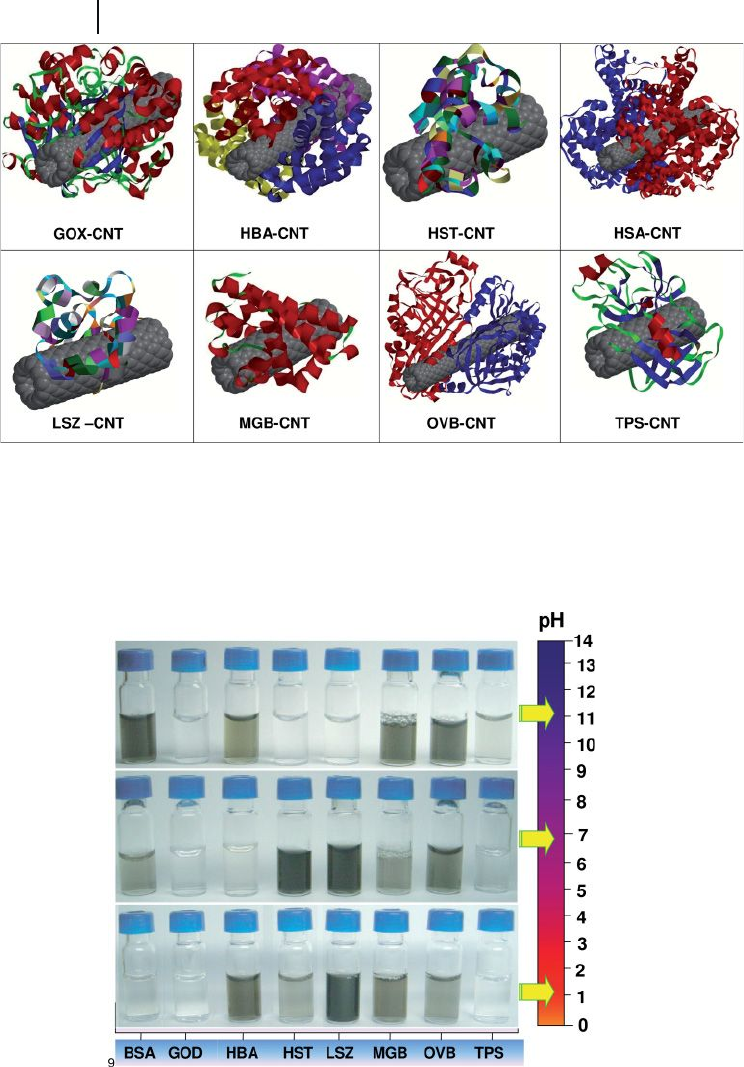
728 23 Interactions of Carbon Nanotubes with Biomolecules: Advances and Challenges
Figure 23.10 Vials containing the SWNT products obtained
from different proteins at different pH values. From left:
bovine serum albumin ( BSA ), glucose oxidase ( GOX ),
hemoglobin (HBA), histone (HST), lysozyme (LSZ),
myoglobin ( MGB ), ovalbumin ( OVA ), and trypsin ( TPS ). The
arrow in each row indicates the pH range of the respective
solutions.
Figure 23.9 Schematic representations of the
single - walled carbon nanotube ( SWNT )
adducts with different proteins: glucose
oxidase (GOX - SWNT), hemoglobin (HBA -
SWNT), histone (HST - SWNT), human serum
albumin (HSA - SWNT), lysozyme (LSZ –
SWNT), myoglobin (MGB - SWNT), ovalbumin
(OVB - SWNT), trypsin (TPS - SWNT). Color -
coding: secondary structure for GOX, MGB,
and TPS; amino acid residue sequence for
HST and LSZ; and strand for HAS, HBA, and
OVB.
